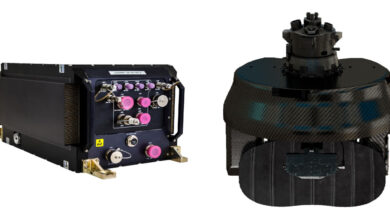‘Atmanirbharta’ in Defence Manufacturing: We are on Fast Track
- ‘Atmanirbharta’ crucial in defence sector amid growing geopolitical tensions
- Defence gets Rs. 5.94 lakh crore in Budget 2023-24, a jump of 13% over the previous year
- In recent years, the government has enacted a slew of legislative measures and reforms to encourage indigenous design, development, and manufacture of military equipment, hence encouraging self-sufficiency in the defence industry and technology in the country
- The nation is continuously and consistently heading to become the leading country of the world in defence sector, Aerospace and Naval Ship Building sectors from design to production fulfilling twin objective of self-reliance and exports supported by innumerable strategic and policy initiatives. The initiatives have been wide ranging from procurement reforms, investment promotion, innovation and R&D to export promotion
- Self-reliance in the defence industry will enhance India’s strategic independence and promote development in the country’s domestic defence and aerospace industry
- Private sector will benefit from the transformation due to export authorisation and the embargo imposed by the government on import of various products
- India will be able to reduce its reliance on imports by increasing domestic production
- India will be able to boost exports and achieve its 2025 export target of Rs. 36,500 crore (US$ 4.8 billion)
- India’s Present Exports stands at over Rs. 16,000 Crore, exporting its defence products to over 85 Countries

Bangalore, June 24. The Atmanirbhar Bharat Abhiyaan, or Self-reliant India campaign, is a movement which was launched by the Prime Minister Narendra Modi, in May 2020. The Abhiyan aims to make the citizens of India self-reliant in all aspects.
The Prime Minister of India outlined five major pillars of self-reliant India: economy, infrastructure, system, vibrant demography and demand.
Under the Aatmanirbhar Bharat Abhiyaan, the government plans to implement various reforms to lure investors, improve ease of doing business and reinforce the Make in India initiative. Furthermore, the government of India declared enablers and government reforms in various sectors.
The Government of India has taken several policy initiatives in the past few years under ‘Make in India’ program and brought in reforms to encourage indigenous design, development and manufacture of defence equipment in the country.
In pursuance of the policy of Government of India for “Make in India” and the mandate given in “Aatmanirbhar Bharat Abhiyan” for indigenization and promotion of Indian industry, the proposals which were accorded Acceptance of Necessity (AoN) under Buy (Global) category of Capital Acquisition in the past have been reviewed as per DAP-2020.
Liberalisation of Foreign Direct Investment (FDI) policy allowing 74% FDI under automatic route; Simplification of Make Procedure; Launch of Innovations for Defence Excellence (iDEX) scheme involving start-ups & Micro, Small and Medium Enterprises (MSMEs); Implementation of Public Procurement (Preference to Make in India) Order 2017; Launch of an indigenization portal namely SRIJAN to facilitate indigenisation by Indian Industry including MSMEs; Reforms in Offset policy with thrust on attracting investment and Transfer of Technology for Defence manufacturing by assigning higher multipliers; and Establishment of two Defence Industrial Corridors, one each in Uttar Pradesh and Tamil Nadu.
In Amrit-Kaal, India is preparing to take centre stage on the world arena. This voyage, however, may not be without difficulties. India has fought multiple wars and faced several challenges to its national security throughout modern history.
Atmanirbharta in the defence sector
In recent years, the government has implemented many legislative measures and reforms to stimulate indigenous design, development, and manufacture of defensive equipment, hence fostering self-reliance in defence manufacturing and technology in the country.
Our defence sector can currently produce a wide range of high-end requirements, such as tanks, armoured vehicles, fighter aircrafts, helicopters, warships, submarines, missiles, electronic equipment, special alloys, special purpose steels, and a large range of ammunition.
Rapid progress has been achieved towards obtaining comprehensive Aatmanirbharta in the domestic production of military equipment for our Armed Forces.
A total of 595 Industrial Licences have been given to 366 enterprises operating in the Defence Sector till October 2022, as per a government release.
As a result, several cutting-edge items have been produced, including the 155 mm Artillery Gun System ‘Dhanush,’ Light Combat Aircraft ‘Tejas,’ Su-30 MK1, Cheetah Helicopter, INS Kalvari, INS Khanderi, INS Chennai, and Integrated Air Command and Control System (IACCS).
In recent years, India has also produced Software Defined Radios (SDR), Lakshya Parachute for Pilotless Target Aircraft, 25 T Tugs, and other items. These are just a few items to be named.
Why is Atmanirbharta important?
India is a vast country and consistently faces threats from China and Pakistan, primarily.
India has land borders with seven countries: Pakistan, China, Nepal, Bhutan, Bangladesh, Myanmar, and Afghanistan. The Arabian Sea to the west, the Bay of Bengal to the east, and the Indian Ocean to the south encircle India’s 7,500-kilometer coastline.
The coastal region of India is vital because of its strategic location, which allows easy access to critical maritime routes connecting the Middle East, the rest of Asia, Europe, and Africa.
The Indian Ocean Region or IOR is one of the most important spots on the globe. The coastal region is also a marine commerce centre and plays an important part in the Indian economy, contributing considerably to the country’s GDP.
Safeguarding it is not an easy task.
Given its geopolitical location, numerous security threats, and the need to upgrade its armed forces, India’s defence self-reliance is vital. The capacity to design, develop, and produce defensive equipment and systems in-house with limited reliance on foreign suppliers is needed.
India has previously relied on imports to satisfy its defence needs, resulting in challenges such as cost overruns, delays, and technology obsolescence.
To lessen its reliance on imports and attain self-sufficiency in defence, India has implemented a number of initiatives, including the “Make in India” programme, which encourages private sector participation in defence manufacturing and promotes defence technology research and development.
Aatmanirbhar Bharat Abhiyan will create several opportunities for start-ups and private sector companies to showcase their domestic capabilities.
The government’s role as a mediator will help improve the processes and boost the sector.
However, it is crucial that the industry works in tandem with the government to achieve self-reliance and the US$ 5 trillion economy target.
India is significantly realising the need for self-reliance. The country is drastically reducing its import needs and promoting domestic defence capabilities.





